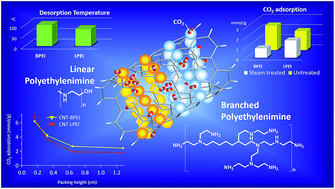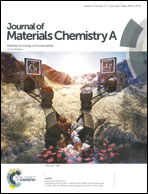Stability and efficiency of CO2 capture using linear amine polymer modified carbon nanotubes†
Abstract
Increasing atmospheric CO2 concentration has become a cause for concern. The design of efficient and stable solid amine adsorbents for CO2 capture, as well as for controlled release, is urgently needed. Polymeric amine modified multiwalled carbon nanotubes (CNT) are a promising material for meeting these goals. In this study, linear polyethylenimine (LPEI) was supported on CNT and was characterized and studied for reversible CO2 adsorption. These results are compared to branched polythylenimine (BPEI) as well as other materials. Upon treatment with 3 M NaOH or 5 M HNO3, the CO2 adsorption was decreased by at least 15%. The CO2 adsorption by LPEI (1.89 mmol g−1) was lower than that of BPEI (2.43 mmol g−1) when coated on CNT supports. The desorption temperature was noticeably lower on CNT–LPEI versus CNT–BPEI for complete CO2 removal. CO2 adsorption capacity was strongly dependent on the packing height of the material in the column reactor. The stability study showed that CO2 adsorption of CNT–LPEI and CNT–BPEI decrease by 9.5% and 61.7%, respectively, after steam treatment, indicating that LPEI was more stable under humid conditions.



 Please wait while we load your content...
Please wait while we load your content...